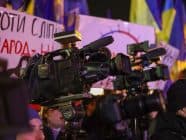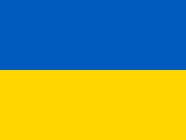On November 21, Mustafa Nayyem, one of Ukraine’s top journalists, called on his Facebook friends and followers to gather at the Monument of Independence at 10.30 p.m. to protest against the government’s decision to back away from European Union integration talks.
“Put warm clothes on, take umbrellas, tea, coffee, positive mood and friends,” his message read. Nearly 1500 people gathered on Maidan Nezalezhnosti (Independence Square) in the capital Kyiv that night.
The gathering has now grown into a massive, well co-ordinated, socially networked protest movement in which the Ukrainian media has come of age.
Three days after Nayyem’s initial call to action around 100,000 people joined a formal rally in support of European integration. Similar rallies, named ‘EuroMaidan’, took place across the country and beyond its borders: there have been demonstrations in more than ten European cities, Canada, USA and Israel.
Photos of thousands of people crowding the streets of Ukrainian cities evoked memories of the Orange Revolution in 2004, but this current wave of protests is different.
There is no single leader leading or symbolizing the protest movement; instead, EuroMaidan has sprung from several grass root civic initiatives.
The protests have also been more violent. On November 30, riot police violently dispersed protesters in a dawn raid on Maidan Nezalezhnosti. On December 1, around 500,000 people took to the streets, demanding that the government stop down and that president Viktor Yanukovych is impeached. The violence intensified after some protesters, who opposition leaders claim were deliberately planted provocateurs, tried to take over the president’s offices. Hundreds were injured. Over 40 journalists and photographers were hurt: many of them appear to have been deliberately beaten by the riot police, despite carrying, and showing press passes.
One of the key differences is the role of the media. During the Orange Revolution, the mainstream media were brutally effective in silencing dissent. The media environment now is much more in flux.
Diana Dutsyk, a media observer and chief editor of the MediaSapiens online publication points out many mainstream television channels are owned by oligarchs loyal to the government, but several stations like Inter, 1+1, ICTV have begun live coverage of protests. “The question is whether TV channels will be further allowed to provide unbiased coverage of the events”, Dutsyk added.
By coincidence, a new online TV channel hromadske.tv, a collective station funded by voluntary donations, began broadcasting just as protests began. Many journalists who work there had quit their previous jobs in television because of censorship and relish the freedom to cover these protests independently. The station has had a good start and has about 40,000-50,000 simultaneous viewers.
City guides and online fashion publications have been covering EuroMaidan protests, offering their readers interactive maps indicating places to warm up, access free Wi-Fi
The Hashtag #Euromaidan (#Євромайдан in Ukrainian) is now the most popular hashtag in Ukrainian Twitter. According to media expert Maksym Savanevsky, there were 1500-3000 tweets with #Euromaidan hashtag every hour during the first week of protests. Users of social networks have made hundreds of thousands of posts with a #Euromaidan hashtag, contributing to live reporting of protests.
The official “EuroMaidan” Facebook page attracted nearly 140,000 likes in the course of two weeks, the community “EuroMaidan SOS” which offers legal and other kinds of assistance to protesters – more than 20,000. The EuroMaidan page has turned into a real news aggregator offering news updates, logistical information for protesters, video shot by witnesses of events, links to media stories on protest movement. In their recent report on the use of Facebook and Twitter by Ukrainian protesters, Pablo Barbera and Megan Metzger from the NYU Social Media and Political Participation (SMaPP) laboratory, point out that Ukrainian Facebook users have been extensively interacting with the information posted on EuroMaidan page. “The 2000 updates posted on the page since it was created have garnered close to 50,000 comments and over a million likes; and their content has been shared over 230,000 times,” researchers note.
Facebook has also proved to be an efficient platform for various grass root initiatives and causes within EuroMaidan movement. For example, users created a group called “KyivHost” where Kyiv residents can offer places to stay for protesters from other cities. Social networks enabled a much more dynamic engagement of public when it comes to sharing information, reporting, awareness-raising activities etc.
Furthermore, citizens have been efficiently utilizing not only user-friendly social networks, but other multimedia instruments like interactive graphics, live video streaming, crowdfunding projects. A newly created website Euromaidan.eu accumulates all posts with a hashtag #Euromaidan from social networks. It also contains an interactive map depicting all cities that support Ukraine with protests, live video broadcasts of hromadske.tv, Radio Free Europe/Radio Liberty and a mobile app “Ustream” to upload video
Of course social media can be manipulated.The hashtag #Euromaidan has also been used to disseminate misleading information and incite panic. One message suggested the military was being deployed to break up protests. A manipulated photo image depicting a protester beating a riot police officer with a truncheon has also been circulating in the social networks.
The line between journalism and activism has been utterly blurred in the Euromaidan protests.
Many journalists have used their Facebook and Twitter accounts, not just to inform readers but to call for action. Many reporters have joined rallies and even addressed the crowds from the stage. After the riot police attacked protestors, two business publications, Delo and Investgazeta issued statements in support of the movement.
What remains to be seen is just how long Ukraine’ journalists can walk this fine line, maintaining their hard won independence, reporting on change as they bring it about themselves.
Photo credit: Alexandra (Nessa) Gnatoush / Flickr Cc
Tags: EuroMaidan, EuroMaidan SOS, Freedom of Expression, Maidan Nezalezhnosti, MediaSapiens, Mustafa Nayyem, orange revolution, revolution, role of media, Ukraine, violent protest











































